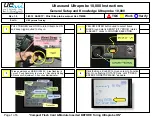
www.fieldpiece.com www.fieldpiece.com www.fieldpiece.com www.fieldpiece.com www.fieldpiece.com www.fieldpiece.com www.fieldpiece.com www.fieldpiece.com www.fieldpiece.com www.fieldpiece.com www.fieldpiece.com
6 8
6 9
5.506 Undercharged, add refrigerant until actual superheat
reaches target superheat. Your actual superheat is __°F
and your target superheat is __°F:
This fixed metering device
system is low on refrigerant. Add refrigerant until the actual superheat is
within ±5°F (Grant = None) of the target superheat. The closer the actual
superheat is to the target superheat, the better.
5.507 Undercharged, add refrigerant to obtain 6°F of super-
heat:
This fixed metering device system is low on refrigerant. Since the
test conditions are hot outside, dry inside, or both, the exact target su-
perheat cannot be determined. Because the actual superheat is greater
than 6°F the unit is undercharged. Add refrigerant until the superheat
is 6°F.
5.508 Charge unknown, raise indoor temperature to obtain a
target superheat ≥ 5°F and retest:
Since the test conditions are
hot outside, dry inside, or both, the exact target superheat cannot be de-
termined. This fixed metering device system may be correctly charged or
overcharged. It may be possible to open windows or run the furnace to
change the indoor conditions enough to obtain a target superheat upon
a retest.
5.509 Possible overcharge, possibly remove refrigerant:
Try fix-
ing other conditions first and retesting, but if this diagnosis persists, the
system may be overcharged. If no other conditions are triggered, consid-
er recovering refrigerant to correct. The amount of refrigerant to recover
will vary based on the size of the system and the difference between Tar-
get and Actual superheat/subcooling.
5.510 Overcharged, recover refrigerant until actual superheat
reaches target superheat. Your actual superheat is _°F and
your target superheat is _°F:
There is too much refrigerant in this
non-TXV system. Remove refrigerant until the superheat is within ±5°F
of the target superheat. The closer the superheat is to the target, the bet-
ter.
5.511 Overcharged, recover refrigerant until actual subcool-
ing reaches target subcooling. Actual subcooling is _°F
and target subcooling is _°F:
There is too much refrigerant in
this TXV/EXV system. Remove refrigerant until the actual subcooling
is within ±3°F (Grant = None) of the target subcooling. The closer the
actual subcooling is to the target subcooling, the better.
5.512 Undercharged, add refrigerant until actual subcooling
reaches target subcooling. Your actual subcooling is _°F
and your target subcooling is _°F:
This TXV/EXV system is
low on refrigerant. Add refrigerant until the subcooling is within ±3°F
(Grant = None) of the target subcooling. The closer the actual subcool-
ing is to the target subcooling, the better.
5.6 Refrigerant Lines and Metering Devices Diagnosis
Refrigerant line restrictions, incorrect orifice sizes, and TXVs improp-
erly installed are common. Any of these can lead to compressor failure.
If there are restrictions in the refrigerant lines (pinches, dirty filter dri-
ers), the charge measurements will provide contradictory information; and
getting proper performance will not be possible. Similarly if the orifice of the
metering device is too small or partially blocked by foreign material in the
refrigerant (such as chips and flakes from improper brazing techniques), the
unit will not perform to specifications.
If a fixed orifice is too large (not matched to the inside coil), the refriger-
ant will not meter properly, contradictory measurements will be obtained.
A thermostatic expansion valve (TXV) only works when the sensing
bulb is in solid contact with the suction line and only senses the temperature
of the suction line. Therefore, it must be well insulated from surrounding air.
The TXV is designed to maintain a constant superheat.
5.601 Possible oversized metering orifice, consult manufac-
turer’s specifications:
The metering orifice is suspected of letting
too much refrigerant through. Check that the orifice is sized properly.
Find the metering device part number and obtain the orifice size from
the manufacturer or distributor and verify the size is appropriate for the
air conditioner.




































